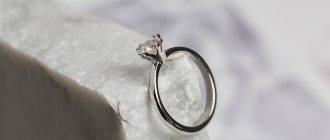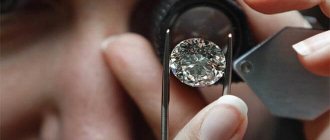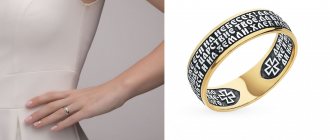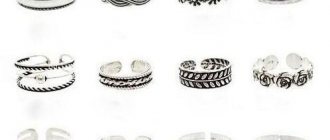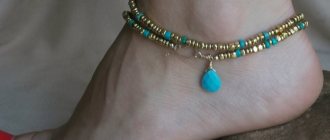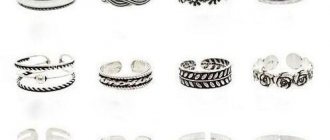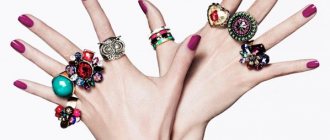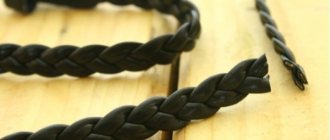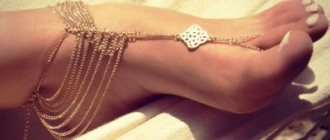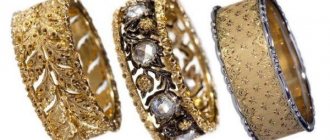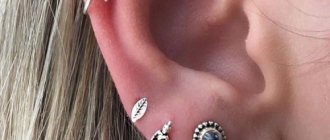Diamonds are clearly not a necessity: you can live happily ever after without them. Nevertheless, jewelry with these magic stones is in constant demand.
Diamonds are irresistibly attractive: even a person far from jewelry art cannot help but admire the exquisite play of light in laconic facets. However, admiration for the incredible tears of the Earth is often accompanied by bitterness, because this beauty has a very impressive financial manifestation.
Yes, a ring with a large diamond really costs a lot. However, if you approach the purchase wisely and do not covet premium stones, you can acquire such jewelry without having to sell your apartment and car.
Today you will learn how to choose the right diamond ring in order to please your soul and not be left without a livelihood.
How to choose a diamond ring
To begin with, it is better to choose a diamond ring from the selection of a reputable jewelry store. This way you will be absolutely sure that you are purchasing a product with a certified stone, the characteristics of which are documented.
However, if you want to save money without putting yourself at risk, you can order the jewelry to be made in a jewelry workshop, having previously taken care of purchasing the stone.
When making a ring with a relatively large diamond (from 0.2 carats) with good characteristics, this approach is quite economically justified. This will take more time and effort than purchasing ready-made jewelry. However, the gain in price will be 10-15 thousand rubles, or even more!
When you start studying this topic, you will be bombarded with offers, one more tempting than the other. There are a lot of online resources that offer cut diamonds for every taste and budget. Naturally, you need to choose exclusively official platforms and carefully familiarize yourself with their range.
You can contact foreign online stores, for example, American ones. But you need to understand that you will have to pay for delivery and insurance of the stone, which will eat up the lion's share of the benefit. It is better not to look at Asian resources: the prices there, of course, are pleasant, but often do not correspond to the characteristics of the stones.
Gold ring “Diamonds of Yakutia” in the SUNLIGHT catalog
Russian cutters and suppliers have higher prices than Asians and even Americans. However, we must take into account that in this case, delivery costs will be minimal, and if you live in a large city, even zero.
Making a ring with a small diamond will take about a week or two, but you will receive the jewelry at a very reasonable price. But if time is pressing, you will have to come to terms with the inevitable increase in costs and purchase ready-made jewelry.
Under no circumstances buy diamond jewelry second-hand or from unverified sellers! Purchases during tourist trips to Eastern countries are especially risky: gold may turn out to be “samovar”, and diamonds may turn out to be cubic zirconia.
Metal frame.
Choosing a metal for your setting comes down not only to what color you would prefer, but also to how durable your ring will be.
Platinum is a popular choice for people who want a white ring that will withstand wear and tear. However, this metal is also one of the most expensive.
White gold is also a good choice if you want a metal that is as white as platinum but not as expensive.
This material is slightly less durable, and white gold must be re-plated with rhodium every few years to restore its color when the top layer of the band begins to wear off.
Yellow gold is a good choice if you love color, but keep in mind that this metal is softer than platinum or white gold. If durability is important to you, then you should consider 10 or 14 karat gold: the lower the karat of gold, the harder and more durable the alloy.
What to look for when purchasing
The cost of a gold ring with a diamond is formed from several components:
- stone prices;
- the cost of gold;
- price list of jeweler's work.
When pricing, some non-obvious points are also taken into account, in particular, the history of the jewelry (if you are not purchasing it new) and the brand’s policy. Naturally, a diamond ring from Tiffany & Co. or Cartier will cost significantly more than a similar product from a little-known manufacturer.
But all this is dust: the main thing in a diamond ring is the diamond itself, especially if we are talking about a medium or large specimen. And they get it from diamond through the most complex cutting.
Diamonds are pure carbon, which due to geological processes has acquired unprecedented strength. These processes take millions of years: first, carbon turns into graphite, and then, deep in the bowels of the earth, at high temperatures and monstrous pressure, it turns into diamond.
It cannot be said that a diamond is a very rare substance, but not every stone is capable of turning into a diamond and decorating a piece of jewelry. Only the largest and purest diamonds become diamonds, and their less presentable counterparts turn into technical raw materials.
Russia is one of the world leaders in the mining of gem-quality diamonds. The largest deposits of Russian diamonds are located in Yakutia. Our country's main competitors in the international market are some African countries and Canada.
Let's take a closer look at the characteristics of these fantastic minerals and other points that are fundamental when choosing diamond rings.
A little about certification
If you want to be 100% sure of the characteristics of the stone, you need to buy a diamond or jewelry with a certificate. However, there are subtle points here too.
A certificate is, in fact, a passport of a stone, which indicates its main characteristics: weight, color, clarity, shape and quality of cut, as well as the features inherent in a particular diamond.
The most authoritative certification center is the American GIA: its assessment of the quality of stones is not questioned throughout the world. Certificates from some other American and European government laboratories are no less highly valued.
But Asian laboratories often sin by formally improving the characteristics of stones to please sellers. However, commercial certification centers in any country enjoy much less authority than government laboratories.
The evaluation of stones should be carried out by independent experts who are not interested in “improving”. The higher the clarity and better the color of a diamond, the more expensive it is. But these characteristics cannot be measured objectively - only by the trained human eye!
Not all diamond suppliers care about obtaining certificates, especially for small pieces. An independent examination from a reputable laboratory is expensive, so not every supplier is willing to bear the associated costs.
So, when buying diamond jewelry abroad with third-category certificates (from low-reputable commercial companies) or without them at all, you are taking a big risk. In the best case, you will buy a diamond ring at a real price, seduced by a dizzying discount - the certificate states that a stone with inflated characteristics is inserted into the jewelry.
In Russia, the situation is much rosier: every diamond is subject to mandatory certification. The sale of jewelry, with or without diamonds, is regulated by the state.
Each jewelry made of precious metals is equipped with a special tag, which indicates its weight and characteristics of the inserts. If a medium or large diamond is used as an insert, it is often accompanied by a gemological certificate. It can be replaced by a product passport, which details the characteristics of the inserts, sometimes even with a photo attached.
The sale of diamonds to individuals without certificates of conformity in Russia is punishable by law. However, this applies specifically to stones without a frame: if you buy ready-made jewelry, there may be no gemological certificate, but the characteristics of the inserts must be indicated on the tag.
Gold ring with diamonds (go to the SUNLIGHT catalogue)
Stone size
One of the basic characteristics of a diamond is its weight. It is also interesting that this is the only characteristic that can be measured in basic units. When applied to precious stones, the carat is traditionally used as such.
Since ancient times, jewelers have used the seeds of the pod tree (carat) as a basic standard. The weight of such a seed is only 0.2 grams. Do you think this is very little? In fact, this is already a very impressive and expensive pebble with a diameter of over 6 mm. Despite the good characteristics of the stone, not everyone can afford a ring with a carat diamond.
The following system for grading diamonds by weight has been adopted in Russia:
- 0.002-0.29 carats – small. The smallest pebbles are rated by diameter and total weight. Diamonds in this category weighing 0.1 carats or more are most often used for making engagement rings in the mass sector. Smaller stones are usually mounted in a ring of several pieces.
- 0.3-0.99 carats – average. These are already very decent diamonds, close to premium ones. However, if the stone is not distinguished by high purity and impeccable color, you can afford a larger diamond with a small budget.
- From 1 carat – large. Here are exclusive and very expensive stones (of course, with proper purity and transparency). You won’t see them in mass-produced jewelry, because the price of a good stone weighing one carat starts at 10 thousand dollars.
The value of a stone increases with weight not in arithmetic, but in geometric progression. The larger the stone, the more expensive it is, and a diamond weighing one carat will cost many times more than two half-carat counterparts of similar clarity, color and cut quality.
Diamonds weighing less than 0.002 (category “edge”) are not cut. Crumbs of gem-quality diamonds are used in jewelry design, and crushed beads are used to make abrasives and drilling equipment.
Color
An ideal diamond should be absolutely colorless, with a slight bluish tint allowed. All shades of yellow or brown are classified as imperfections.
The GIA classification uses lettered color designations. Diamonds of color D are considered ideal; in the middle of the table there are stones with yellow and brown tints of varying degrees of severity, at the end there are cut diamonds of brown and black colors.
The Russian grading system GOST R 52913-2008 reflects the colors of diamonds according to a similar scheme, but in numbers (lower on the scale - in letters and numbers), and stones weighing up to 0.29 and over 0.3 carats are valued separately. The Russian standard is considered more complex, specific and scientifically based, therefore it is used in many European countries and even in Japan.
The highest GIA color grades are D, E and F (1, 2 and 3 in the Russian system). These are practically colorless stones that are not used for making mass-produced jewelry. Such stones are usually purchased for investment purposes or for making exclusive jewelry.
GH color diamonds have slight tint. They are much cheaper and are more often used in the production of jewelry. By the way, only a specialist can notice a tint that reduces the value of a diamond, so you can safely save on this point. Even frankly yellowish and brownish stones in yellow and rose gold look absolutely colorless to non-specialists.
Where are the purity scores A and B in the GIA system? There are none yet: it is believed that they are reserved in case a natural diamond of flawless color can be obtained.
In addition to classic transparent diamonds, there are also diamonds painted in various colors: blue, blue, green, purple, red and so on. They are called fantasy.
Fancy diamonds, on the other hand, value the intensity and beauty of color. A bright yellow pebble will be considered fancy rather than low-grade clear.
The rarer and richer the color (of course, while maintaining the transparency of the stone), the higher its price. The rarest and most expensive are green and red diamonds - they are sold only at auctions. The cheapest and most widespread are bright yellow and brown (cognac) specimens. You can afford small stones of this color even if your budget is not too extensive.
Black diamonds, which, in fact, are not diamonds, are also relatively inexpensive. But if they retain some transparency and play of light, the price of a one-carat black stone can exceed a thousand dollars.
GIA has developed systems for grading fancy colored diamonds based on color. In Russia there is no GOST standard for colored stones, so each specimen is assessed individually.
Previously, black diamonds were clearly classified as “cut” and were used exclusively for technical purposes. However, in the 90s of the last century, they suddenly soared to the peak of popularity and began to cost quite a lot.
Purity index
Another important indicator that affects the cost of a diamond is its purity, that is, the degree of transparency. In this case, the type and number of inclusions, that is, extraneous inclusions, are important.
There are no absolutely flawless natural diamonds, so inclusions will be present even in the best stone. Optimal are single light inclusions located along the edges of the stone and minimally affecting the play of light.
Russia has adopted a digital classification of diamond purity. Stones with a clarity of 1-3 are very expensive and represent investment value. Diamonds of purity 4-5 and below are used to make jewelry.
If you are choosing a diamond ring, it is better to choose a larger stone, but of low clarity and imperfect color. This will make the purchase more affordable, and inclusions even in a diamond with a clarity of 7-8 are noticeable only upon very close examination by a specialist.
Stones with an abundance of dark inclusions are classified as “pique”. They also have a peculiar charm, and are much cheaper than their impeccable counterparts.
Cut
The round cut is considered a classic of the diamond genre. That’s what it’s called – diamond. On top of the stone there is a crown with a flat platform, below there is a pavilion, and along the edge there is a girdle. This shape allows the famous diamond shine to fully manifest itself: the stone seems to scatter sparkles of light.
Diamonds weighing up to 0.03 carats in Russia are cut into 17 facets. According to the standard, larger specimens already have 57 facets, and exclusive stones over 6 carats can be cut into 74, 86 and even 102 facets. True, they are already being sold at auctions and are clearly inaccessible to mere mortals.
The round cut is the most valuable, but not the only shape of diamond. Sometimes, in order to maximize the beauty of the stone and remove visual imperfections, cutters give nature’s masterpieces other shapes: “pear”, “marquise”, “oval”, “heart”, “emerald”, “baguette” and so on.
Cutting quality is one of the fundamental cost criteria. Imperfect work by a craftsman can reduce the price of a stone by 10 percent or more.
Gold ring with baguette-cut diamonds (go to SUNLIGHT catalogue)
All of the above applies to natural diamonds that have not been artificially enhanced to eliminate defects. Synthetic diamonds and treated stones are significantly cheaper and are priced separately.
Setting and setting
In serial jewelry, diamonds coexist exclusively with white, pink and yellow gold, and less often with platinum and palladium. If, for some whim, you want to frame an exclusive stone with an alternative metal, you will have to make a custom-made ring.
Now you will have to strain yourself and understand the types of settings for diamonds in the setting. Believe me, this is a very important point!
There are dozens of variations of diamond settings, but they can be divided into several broad groups.
Krapanovaya
This is the most popular method of attaching relatively large and clean stones: the diamond is fixed with 4-8 prongs, remaining practically open. Prong setting is good because the fastening tabs practically do not interfere with the play of light, and the stone appears as large and shining as possible. However, the prong fastening is not reliable, and the paws can cling to clothes and hair.
Deaf
The blind setting securely fixes the stone on all sides - this is an obvious plus. However, it partially hides the diamond, making it appear smaller, and the play of light suffers as a result. This is the best option for large, but not perfectly clean stones: defects along the edges are completely hidden, and the central ones become less noticeable. An intermediate option is a semi-blind setting: the stone is not fixed completely, but on both sides.
Corner
This type of fastening is considered very reliable, but difficult to perform. The insert is fixed directly into the metal mass using corner posts machined from it. In fact, the stones are secured with metal shavings. There are many variations of corner setting, but for fixing many small stones, its “pave” variety is more often used.
Rail or channel
Everything is very simple: pebbles of the same size are placed sequentially in a special channel. As a rule, diamonds are attached to the rim of the ring in this way, forming a spectacular sparkling belt. One bad thing: it is not possible to change the size of such decoration.
Spring
The diamond is fixed at only two points (inserted into the grooves of the metal) and remains open on all sides. This provides an ideal play of light and contributes to the visual enlargement of the stone, but has a negative impact on the reliability of fastening, especially if we are talking about jewelry made of very high standard gold.
Classic prong and spring settings are optimal for fastening single stones with near-ideal color and clarity characteristics. Such jewelry should be handled with the utmost care and be sure to be removed at night and during any physical activity.
Planets and their minerals
In the 16th century, the German researcher Agrippa von Nettesheim, also an alchemist and adherent of occult sciences, discovered that there is a connection between gems and the zodiacal constellations, and interdependence with the planets and elements. He believed that the stones, like the signs of the Zodiac, are connected with the planets, and therefore are their representatives on Earth. Each planet owns several minerals :
- All golden stones and minerals of red shades belong to the Sun - amber, hyacinth, ruby, colored diamond;
- Opal, pearl, rock crystal, coral, aquamarine, moonstone, beryl and all transparent, bluish and white stones are related to the Moon;
- Mercury owns topaz, agate, amethyst, turquoise, peridot, in a word, all precious stones of lilac and violet shades;
- Venus stones are emerald, sapphire, malachite, belomorite, amazonite, green pearl and other green stones;
- Blue minerals have the power of Jupiter: sapphire, topaz, turquoise and lapis lazuli;
- Mars patronizes all minerals with brown tints: jasper, ruby, bloodstone, garnet, diamond, carnelian;
- Saturn's stones are black or very dark: agate, onyx, morion;
- Neptune owns minerals with green-blue hues: rock crystal, aquamarine, moonstone;
- Uranus took the most interesting stones for itself: these are gems with the effect of iridescence and opalescence. The former emit color highlights on their surface in bright light, the latter seem to contain a piece of the rainbow;
- Pluto's minerals are transparent rauchtopaz and variegated jasper.
The list of stones has not been definitively determined and is not limited to strict boundaries once and for all, because the correspondence of planets and stones must be revealed through the prism of the properties of minerals: composition, transparency and shade. It turns out that even recently discovered gems may well add to some list of matches.
As can be seen from the list above, there are stones that may belong to more than one planet. This is explained very simply: usually the mineral contains several basic elements that belong to different celestial bodies. For example, it was recently discovered that the composition of diamond includes impurities of various elements, and even metals in very small quantities.
Standards for astromineralogical compatibility of minerals:
- It is forbidden to wear on one hand and, especially, in one piece of jewelry, stones belonging to different signs of the Zodiac and elements opposite to each other. For example: Water and its signs - Pisces, Cancer, Scorpio, plus Fire with the signs of the Zodiac - Aries, Sagittarius, Leo;
- If the stones belong to friendly elements, then their combination is permissible. Fire and Air (yang), as well as Earth and Water (yin), do not compete with each other;
- If a person knows his element, it is better to select stones that correspond to it;
- There are gems that initially contain two or more elements. It is undesirable if these are warring elements.
Types of Diamond Rings
There are many types of rings that can contain diamonds. For example this:
- Rings. The main role in this jewelry is played by either a single diamond or a group of stones forming the central element. The tavern may contain other decorative elements, including small diamonds.
- Solitaires. In essence, this is a type of ring, but with a single diamond, usually in a classic prong (less often spring) setting. A classic of the genre - an engagement ring a la Hollywood.
- Headbands. This is a well-known format for wedding rings, which can now also be decorated with diamonds. As a rule, these are small stones in a corner or channel setting.
- Long rings. Spectacular rings that span the entire phalanx, or even the entire finger, can also be decorated with shining tears of the Earth. As a rule, these are small diamonds with low characteristics.
- Fantasy rings. This group includes any intricate diamond jewelry, from monogram and trinity rings to elaborate cocktail rings.
Previously, it was believed that “daytime” diamonds were bad manners. However, stylists now agree that not too large stones can be worn at any time of the day, even to work.
Gold wedding ring with diamonds (go to the SUNLIGHT catalogue)
Which finger to wear a diamond ring on?
The classic location of a ring with a diamond (or a group of stones designed as a central element) is the ring or middle finger. On the index finger this decoration looks somewhat provocative, on the little finger it looks interesting but provocative.
A woman is supposed to wear a wedding ring on her ring finger, but what about the engagement ring? The best option is to remove it, because diamonds don’t like being next to each other.
It is correct to wear a diamond ring in splendid isolation, without other rings. But if you really want, you can place the engagement ring in its usual location (the ring finger of your right hand), and put the diamond ring symmetrically on your left hand.
It is generally accepted that rings with large diamonds are reserved only for older ladies. Young girls are entitled to less flashy jewelry with stones up to half a carat.
Friendly and warring celestial bodies
When choosing jewelry in accordance with the doctrine of astromineralogical compatibility, you need to take into account the characteristics of the planets that patronize the stones contained in the product. The theory says that it is impossible to combine stones belonging to warring planets in one piece of jewelry .
- The Sun is at enmity with Saturn, Pluto, Mars, and it also does not get along with the Moon and Mercury;
- Mars and Pluto do not favor the Moon;
- Mercury is at enmity with the Moon, Mars and Pluto;
- Venus does not like Saturn;
- Mars is at odds with Uranus and Mercury;
- Jupiter does not welcome Saturn, Pluto and Mars;
- Saturn is a very harmful planet, it is friends only with Mercury and the Moon;
- Uranus can tolerate Venus, Neptune and Mercury;
- Neptune likes the Sun, Venus, Moon and Jupiter;
- Mars, Pluto and Venus form a commonwealth.
How to care for a diamond ring
Caring for diamond rings is not too difficult. In fact, you just need to focus on the characteristics of the metal into which they are inserted. Diamond is the hardest substance on Earth and cannot be scratched. It is insensitive to household chemicals, resistant to heat (within reasonable limits, of course) and moisture. Under normal conditions it can exist for millions of years.
The only weak point of a diamond is fragility, and even then it is relative. You're not going to hit a stone with a hammer, are you? In general, anything that the setting material can withstand is guaranteed not to harm the diamond. Just be careful with bartacks, especially open ones: this is the most problematic moment.
Diamonds are endowed with enchanting powers. And even if you can only afford a ring with a stone of mediocre characteristics, it will still be your personal diamond, which means it will be the best in the world!
09.11.21
